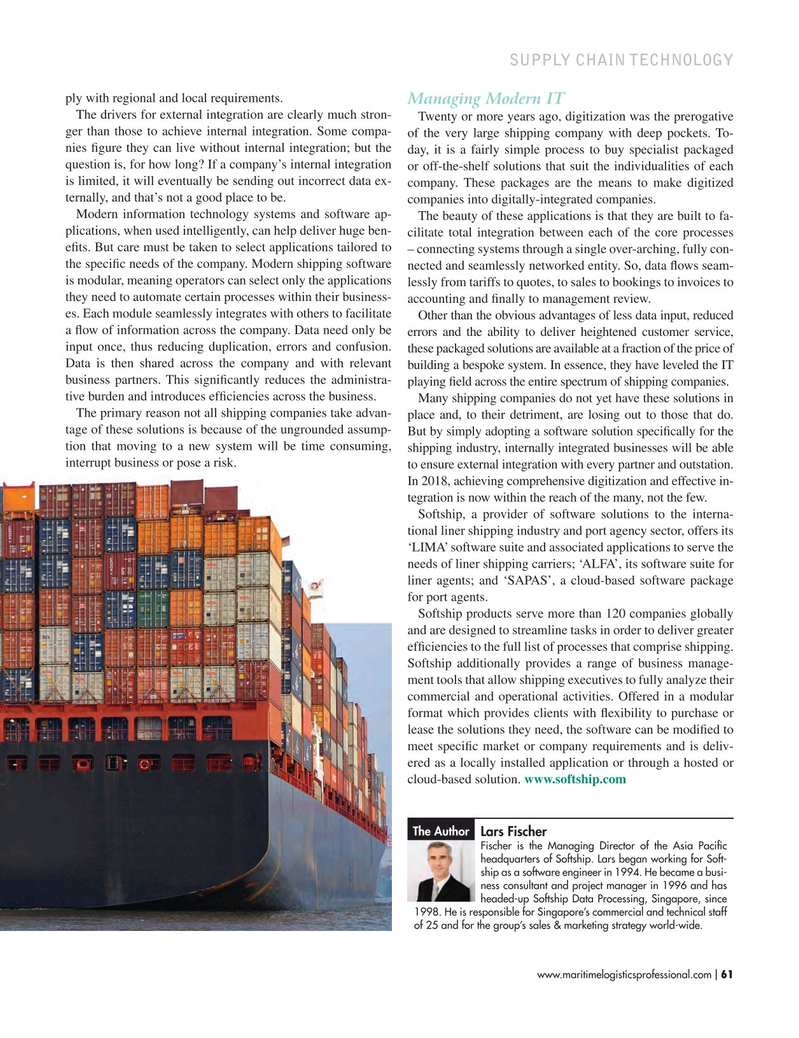
Page 61: of Maritime Logistics Professional Magazine (Jan/Feb 2018)
Cruise Shipping Trends
Read this page in Pdf, Flash or Html5 edition of Jan/Feb 2018 Maritime Logistics Professional Magazine
SUPPLY CHAIN TECHNOLOGY ply with regional and local requirements.
Managing Modern IT
The drivers for external integration are clearly much stron-
Twenty or more years ago, digitization was the prerogative ger than those to achieve internal integration. Some compa- of the very large shipping company with deep pockets. To- nies ? gure they can live without internal integration; but the day, it is a fairly simple process to buy specialist packaged question is, for how long? If a company’s internal integration or off-the-shelf solutions that suit the individualities of each is limited, it will eventually be sending out incorrect data ex- company. These packages are the means to make digitized ternally, and that’s not a good place to be. companies into digitally-integrated companies.
Modern information technology systems and software ap-
The beauty of these applications is that they are built to fa- plications, when used intelligently, can help deliver huge ben- cilitate total integration between each of the core processes e? ts. But care must be taken to select applications tailored to – connecting systems through a single over-arching, fully con- the speci? c needs of the company. Modern shipping software nected and seamlessly networked entity. So, data ? ows seam- is modular, meaning operators can select only the applications lessly from tariffs to quotes, to sales to bookings to invoices to they need to automate certain processes within their business- accounting and ? nally to management review. es. Each module seamlessly integrates with others to facilitate
Other than the obvious advantages of less data input, reduced a ? ow of information across the company. Data need only be errors and the ability to deliver heightened customer service, input once, thus reducing duplication, errors and confusion. these packaged solutions are available at a fraction of the price of
Data is then shared across the company and with relevant building a bespoke system. In essence, they have leveled the IT business partners. This signi? cantly reduces the administra- playing ? eld across the entire spectrum of shipping companies.
tive burden and introduces ef? ciencies across the business.
Many shipping companies do not yet have these solutions in
The primary reason not all shipping companies take advan- place and, to their detriment, are losing out to those that do. tage of these solutions is because of the ungrounded assump-
But by simply adopting a software solution speci? cally for the tion that moving to a new system will be time consuming, shipping industry, internally integrated businesses will be able interrupt business or pose a risk. to ensure external integration with every partner and outstation.
In 2018, achieving comprehensive digitization and effective in- tegration is now within the reach of the many, not the few.
Softship, a provider of software solutions to the interna- tional liner shipping industry and port agency sector, offers its ‘LIMA’ software suite and associated applications to serve the needs of liner shipping carriers; ‘ALFA’, its software suite for liner agents; and ‘SAPAS’, a cloud-based software package for port agents.
Softship products serve more than 120 companies globally and are designed to streamline tasks in order to deliver greater ef? ciencies to the full list of processes that comprise shipping.
Softship additionally provides a range of business manage- ment tools that allow shipping executives to fully analyze their commercial and operational activities. Offered in a modular format which provides clients with ? exibility to purchase or lease the solutions they need, the software can be modi? ed to meet speci? c market or company requirements and is deliv- ered as a locally installed application or through a hosted or cloud-based solution. www.softship.com
The Author
Lars Fischer
Fischer is the Managing Director of the Asia Paci? c headquarters of Softship. Lars began working for Soft- ship as a software engineer in 1994. He became a busi- ness consultant and project manager in 1996 and has headed-up Softship Data Processing, Singapore, since 1998. He is responsible for Singapore’s commercial and technical staff of 25 and for the group’s sales & marketing strategy world-wide.
www.maritimelogisticsprofessional.com 61
I

 60
60

 62
62
